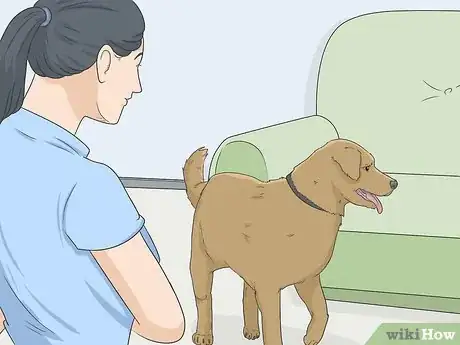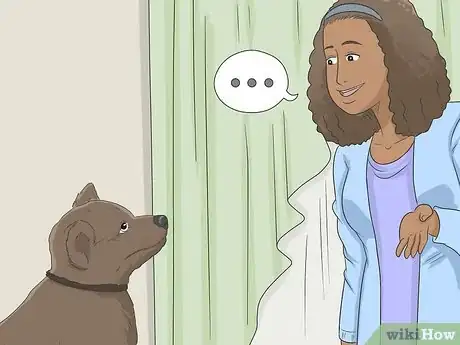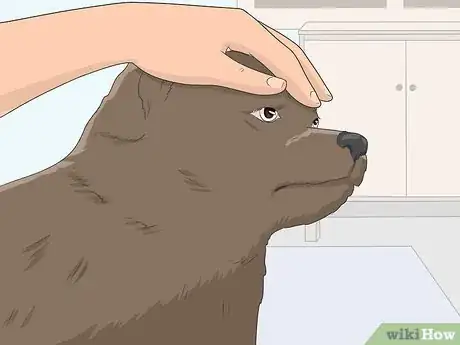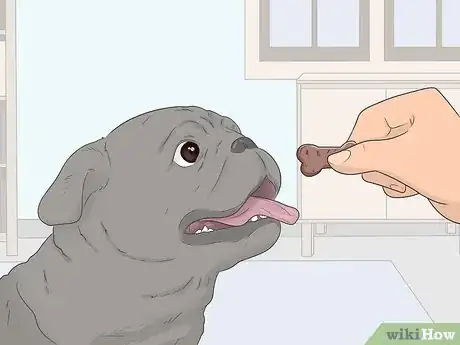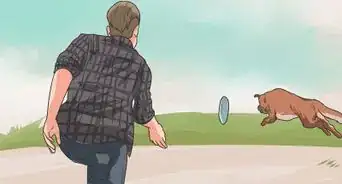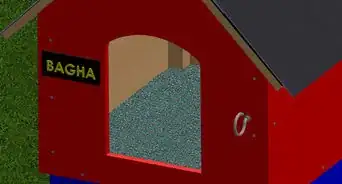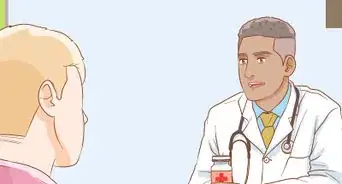This article was co-authored by David Levin. David Levin is the Owner of Citizen Hound, a professional dog walking business based in the San Francisco Bay Area. With over 9 years of professional dog walking and training experience, David's business has been voted the "Best Dog Walker SF" by Beast of the Bay for 2019, 2018, and 2017. Citizen Hound has also been ranked #1 Dog Walker by the SF Examiner and A-List in 2017, 2016, 2015. Citizen Hound prides themselves on their customer service, care, skill, and reputation.
This article has been viewed 1,058,384 times.
House training a puppy or adult dog may seem daunting, but almost any dog can be trained to wait at the door and relieve themselves outside, instead of going into the house. Create a schedule for feeding your dog and taking them outside. Then, reward your dog with treats and praise when they relieve themselves in the designated outdoor spot. Patience and a good sense of humor are all you really need to help your dog adapt to life as a pet in your home.
Steps
Setting Up a Routine
-
1Take your dog outside frequently. This is the most important thing you can do to teach your dog to relieve themself outside. While it may seem excessive, try to take them outside as frequently as possible, about every half an hour. Stick to a schedule and try not to miss even one designated "outside time," since your dog will learn to associate these outside trips with relieving themself.[1]
- If you're training a puppy, you'll need to take them outside more frequently. Puppies have small bladders and can't physically hold their pee for long periods of time.
-
2Put your dog on a feeding schedule. Feed your dog at the same time in the morning and at night, then wait 20 to 30 minutes before taking him outside. Having a feeding schedule will make it easier to predict when your dog will have to go to the bathroom, making housetraining easier.
- Puppies need to be fed three times a day. If you have a puppy, schedule a regular lunchtime feeding as well. Again, a puppy should be given more opportunities to go outside, since it has a smaller bladder.
Advertisement -
3Learn to interpret signs that your dog has to go. Signs include walking around stiffly, sniffing the floor as though they’re looking for a place to go, holding their tail in a funny position, and so on. If your dog shows signs that he needs to go to the bathroom, take them outside right away, even if it's before the designated time to go out.[2] Include a verbal cue, such as saying, "outside" before you take them out. Eventually, you'll be able to ask them if they need to go outside, simply by saying the word.[3]
- When you first start training your dog to go outside, you're teaching them that when they feel the urge, that means it's time to go outside. Each time your dog successfully goes outside, the idea that bathroom equals outside is reinforced.
Tip: Remember to take your dog outside 20 to 30 minutes after every meal and after they drinks water since they’ll likely have to go to the bathroom.
-
4Pick a designated spot outside. Choose in your backyard, or if you don't have one, near a green patch of grass somewhere. Take your dog back to the same place each and every time you go outside. Dogs are creatures of habit. You can help your dog feel comfortable and less anxious by picking a good spot for them to use as their "bathroom" each time they go out. Use a verbal cue such as, "go potty" when you've reached the spot. They’ll learn to associate it with the place.[4]
- Remember to follow your city's ordinances regarding picking up after your pet. If you have no choice but to let your dog use a public spot as their bathroom, you'll need to bring a bag so you can pick up the waste and dispose of it.
-
5Supervise your dog during house training. When you first bring your dog or puppy home, plan to spend a lot of time watching your pet to make sure they don’t go to the bathroom indoors. This supervisory period is imperative because it enables you to teach the dog to quickly associate the urge to use the bathroom with going outside. Intercepting the dog or puppy before they go in the house is the best way to house train quickly.[5]
- If you can't stay home all day to supervise your dog, you'll need to have someone else come over to take the dog out several times during the day. Make sure the person knows to take the dog to the designated spot each time.
-
6Keep your dog in a crate at night and when you're away. If you leave your dog or puppy free to roam the house at night, they are sure to end up soiling the floor. Keeping them in a cozy crate at night and when you're gone reduces the chance that they’ll make a mess. Dogs don't like to soil their dens, so your dog will try to wait until they can go outside to relieve themself.
- Do not let your dog stay in their crate for too long before taking them outside. If you wait too long, they’ll have no choice but to relieve themself in the crate. Dogs need plenty of exercise and playtime too, so you should never leave them crated for more than a few hours at a time or overnight.
Note: Dogs should see their crates as safe spaces and enjoy spending time there. Keeping your dog in a crate is not meant to be a form of punishment. Never punish your dog by banishing them to the crate, or they’ll come to associate it with fear instead of comfort.
-
7Clean up messes right away. If your dog makes a mess in the house (and they definitely will), clean it up right away and use a cleaning solution to get rid of the scent. If your dog smells an old mess in a certain spot, they’ll think of that as a bathroom spot.
- Do not punish the dog for making a mess. Just clean it up and stick to the schedule.
Rewarding the Dog for Good Behavior
-
1Give your dog treats and praise each time he successfully goes outside. Dogs learn best through positive reinforcement and they quickly learn the best way to get it. Every time your dog is able to go to the bathroom in their designated spot, reward them with a little treat, lots of praise, and a scratch on the head.[6]
- You can, of course, reward your dog for other things, like learning how to sit and stay. All good behavior should be rewarded.
Tip: Be consistent when it comes to rewarding your dog. Do it every single time they go to the bathroom in the bathroom spot.
-
2Time the reward correctly. When you're treating your dog for going to the bathroom in their spot, give them a treat and praise right after they finish using the restroom. Don't give it too early or too late, or they won't associate it with going to the bathroom in the right spot.
-
3Consider using a bell or chime to aid in training. Some people have had success using the bell method instead of a treat. When your dog goes to the bathroom in their spot, you ring a bell or pleasant-sounding chime as part of their reward. The dog will come to look forward to the sound of the chime, which should only be used in this specific situation.
- The drawback here is that, eventually, you won't want to keep using a chime or bell every time your dog goes to the bathroom. Initially phasing it out might be confusing to the dog.
-
4Keep your voice and manner light and friendly. Whenever you're taking your dog to the bathroom or talking about it, keep your voice light and pleasant. Never raise your voice or take on a menacing tone, because your dog will start to associate their bodily functions with punishment and fear. If your dog makes a mess inside, you can withhold praise, but don't yell at the dog or make them feel ashamed.
- If using verbal cues, such as "outside", "go potty", or "good dog" be consistent. The repetition of these words along with the action and environment will reinforce where you want your dog to relieve themself.
-
5Never punish the dog for making a mess. Dogs don't respond well to punishment. It scares them and instead of learning to perform well for you, they learn to fear you. Never yell, hit, or do anything that could cause your dog to feel afraid.
- Do not rub your dog's face in their mess. Contrary to some beliefs, this does not teach a dog not to go to the bathroom in the house. The dog will not understand what you're doing and you'll just end up scaring him.
Paper Training a Dog in an Apartment
-
1Pick an out-of-the-way spot that's easy for your dog to access. If you live on a high rise, you won't be able to make it outside every time your dog needs to go to the bathroom. Pick a spot in your apartment that isn't right in the middle of your living space, but is also easy for your dog to access at any time. A corner of the laundry room or kitchen works well. Choose a spot on hardwood or vinyl flooring, rather than carpet.[7]
-
2Line the designated spot with newspaper or training pads. A newspaper is a cheap material you can use to create a bathroom mat for your dog. Absorbent training pads are also available in pet stores. Choose the option that's most convenient for your household.
- You could also use a dog litter tray. If you'll also take your dog outside to relieve themself, consider filling the tray with soil. This way, the dog will learn that it's acceptable to relieve themself outdoors and indoors.
Note: Be aware that your dog may get used to only relieving themself on a newspaper if that's all that you put down.
-
3Take your dog to the spot on a regular schedule. Take your dog to the bathroom mat on a strict schedule, just as you would if you were training your dog to go to a spot outside. Frequently walk them to the mat throughout the day and each time they show signs of needing to relieve themself.
-
4Change the mat often but leave a little spot of dried urine there. The scent of the urine will help your dog remember that the mat is the place to go to the bathroom. Remove feces right away, but leave a sheet of newspaper or a small bit of padding with urine on the clean mat so your dog will naturally know where to go.
-
5Reward your dog for going in the spot. Each time they successfully go on the mat, reward them with a treat, petting, and praise. They’ll eventually come to associate going to the bathroom on the mat with positive feelings, and they’ll start going there without your help before too long.
Expert Q&A
Did you know you can get expert answers for this article?
Unlock expert answers by supporting wikiHow
-
QuestionWhat is the best way to toilet train your puppy?
 David LevinDavid Levin is the Owner of Citizen Hound, a professional dog walking business based in the San Francisco Bay Area. With over 9 years of professional dog walking and training experience, David's business has been voted the "Best Dog Walker SF" by Beast of the Bay for 2019, 2018, and 2017. Citizen Hound has also been ranked #1 Dog Walker by the SF Examiner and A-List in 2017, 2016, 2015. Citizen Hound prides themselves on their customer service, care, skill, and reputation.
David LevinDavid Levin is the Owner of Citizen Hound, a professional dog walking business based in the San Francisco Bay Area. With over 9 years of professional dog walking and training experience, David's business has been voted the "Best Dog Walker SF" by Beast of the Bay for 2019, 2018, and 2017. Citizen Hound has also been ranked #1 Dog Walker by the SF Examiner and A-List in 2017, 2016, 2015. Citizen Hound prides themselves on their customer service, care, skill, and reputation.
Professional Dog Trainer Learn which times your dog needs to go out. Allow your dog to alleviate itself as frequently as you're able, but with an emphasis on a few different times of day. For instance, dogs should go out right after they wake up from a nap, if they've been playing, and 10-30 minutes after they have food or water. Keep trying, even if the dog doesn't go right away. If your dog goes outside but doesn't use the bathroom, continue returning it to the crate for about 15 minutes, then try again. Repeat this as necessary.
Learn which times your dog needs to go out. Allow your dog to alleviate itself as frequently as you're able, but with an emphasis on a few different times of day. For instance, dogs should go out right after they wake up from a nap, if they've been playing, and 10-30 minutes after they have food or water. Keep trying, even if the dog doesn't go right away. If your dog goes outside but doesn't use the bathroom, continue returning it to the crate for about 15 minutes, then try again. Repeat this as necessary. -
QuestionHow do you stop a dog from peeing and pooping in the house?
 David LevinDavid Levin is the Owner of Citizen Hound, a professional dog walking business based in the San Francisco Bay Area. With over 9 years of professional dog walking and training experience, David's business has been voted the "Best Dog Walker SF" by Beast of the Bay for 2019, 2018, and 2017. Citizen Hound has also been ranked #1 Dog Walker by the SF Examiner and A-List in 2017, 2016, 2015. Citizen Hound prides themselves on their customer service, care, skill, and reputation.
David LevinDavid Levin is the Owner of Citizen Hound, a professional dog walking business based in the San Francisco Bay Area. With over 9 years of professional dog walking and training experience, David's business has been voted the "Best Dog Walker SF" by Beast of the Bay for 2019, 2018, and 2017. Citizen Hound has also been ranked #1 Dog Walker by the SF Examiner and A-List in 2017, 2016, 2015. Citizen Hound prides themselves on their customer service, care, skill, and reputation.
Professional Dog Trainer Understand how long your dog can go between trips outside. A good rule of thumb is that a dog can hold its bladder for 1 hour for every month of life, up to 8 months. However, this can only be relied on if the dog is a confined space where they have a reason to try to hold it, like in a crate that's just large enough for them to stand and turn around. Don't forget about nighttime trips. Consider setting at least 1 alarm in the night so you can wake up and take the dog out. That prevents the dog from waking you up with barking or whining, which could become a learned behavior that you don't want.
Understand how long your dog can go between trips outside. A good rule of thumb is that a dog can hold its bladder for 1 hour for every month of life, up to 8 months. However, this can only be relied on if the dog is a confined space where they have a reason to try to hold it, like in a crate that's just large enough for them to stand and turn around. Don't forget about nighttime trips. Consider setting at least 1 alarm in the night so you can wake up and take the dog out. That prevents the dog from waking you up with barking or whining, which could become a learned behavior that you don't want. -
QuestionHow do you retrain a dog to stop using puppy pads indoors and toilet outside instead?
 Pippa Elliott, MRCVSDr. Elliott, BVMS, MRCVS is a veterinarian with over 30 years of experience in veterinary surgery and companion animal practice. She graduated from the University of Glasgow in 1987 with a degree in veterinary medicine and surgery. She has worked at the same animal clinic in her hometown for over 20 years.
Pippa Elliott, MRCVSDr. Elliott, BVMS, MRCVS is a veterinarian with over 30 years of experience in veterinary surgery and companion animal practice. She graduated from the University of Glasgow in 1987 with a degree in veterinary medicine and surgery. She has worked at the same animal clinic in her hometown for over 20 years.
Veterinarian Allow the dog to continue using the puppy pads while you establish a cue word that means it's time for her to relieve herself, such as "Toilet" or "Get busy." Once she is using the pad in response to a command, you can slowly move the pad, inch by inch, as the days go by, to a different location, while instructing her that this is where you want her to toilet with your command. Now, keep a pad on you and place it on the desired toilet spot outside. Give her cue words, and when she goes, make a huge fuss of her. Then scatter a small amount of soil or grass or whatever substrate is your choice onto the pad. Gradually remove the pad.
Allow the dog to continue using the puppy pads while you establish a cue word that means it's time for her to relieve herself, such as "Toilet" or "Get busy." Once she is using the pad in response to a command, you can slowly move the pad, inch by inch, as the days go by, to a different location, while instructing her that this is where you want her to toilet with your command. Now, keep a pad on you and place it on the desired toilet spot outside. Give her cue words, and when she goes, make a huge fuss of her. Then scatter a small amount of soil or grass or whatever substrate is your choice onto the pad. Gradually remove the pad.
Warnings
- Don't try to punish your dog for accidents. Yelling, hitting, or rubbing your dog's nose in the mess won't teach the dog anything useful. If you haven't caught your dog in the act, he won't have any idea what you're so upset about. Hurting your dog in any way is animal abuse.⧼thumbs_response⧽
- Quick trips outside for the dog to relieve itself are not substitutes for exercise or walks. Make sure to exercise your dog regularly.⧼thumbs_response⧽
- Guilty looks are not a sign that your dog understands what they’re done wrong. Your dog is upset because you're angry. Even if your dog does connect your angry behavior to the mess on the floor, it may backfire. Your dog might conclude that you don't want to see them eliminate at all and go to greater lengths to hide it from you, making house training even more difficult.⧼thumbs_response⧽
References
- ↑ http://www.humanesociety.org/animals/dogs/tips/housetraining_puppies.html
- ↑ http://www.humanesociety.org/animals/dogs/tips/housetraining_puppies.html
- ↑ http://www.hartz.com/Dogs/Training_and_Play/Training/how_to_housetrain_your_dog.aspx
- ↑ http://www.hartz.com/Dogs/Training_and_Play/Training/how_to_housetrain_your_dog.aspx
- ↑ https://www.aspca.org/pet-care/virtual-pet-behaviorist/dog-behavior/house-training-your-adult-dog
- ↑ https://www.cesarsway.com/secrets-to-housebreaking-adult-dogs/
- ↑ http://www.perfectpaws.com/htra.html#.VH3YGWR4o7U
About This Article
To house train your dog, take it outside to the same spot everytime you want it to go to the bathroom. Then, wait there for however long it takes your dog to go. When your dog relieves itself, immediately give it a treat so it starts to associate going to the bathroom outside with rewards. Over time, your dog will learn to wait until you go outside together to relieve itself! To learn how to paper train a dog in an apartment, scroll down!




